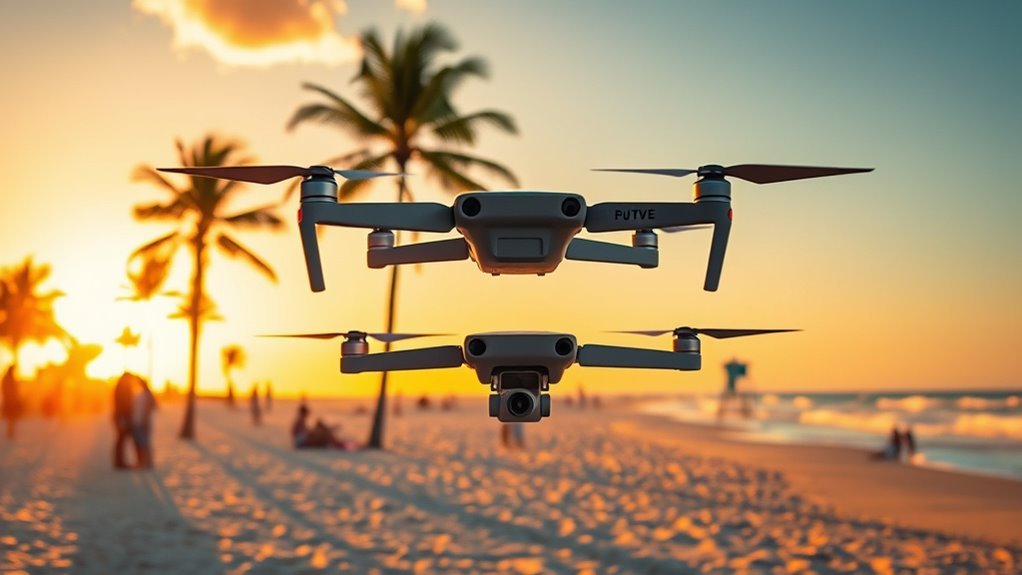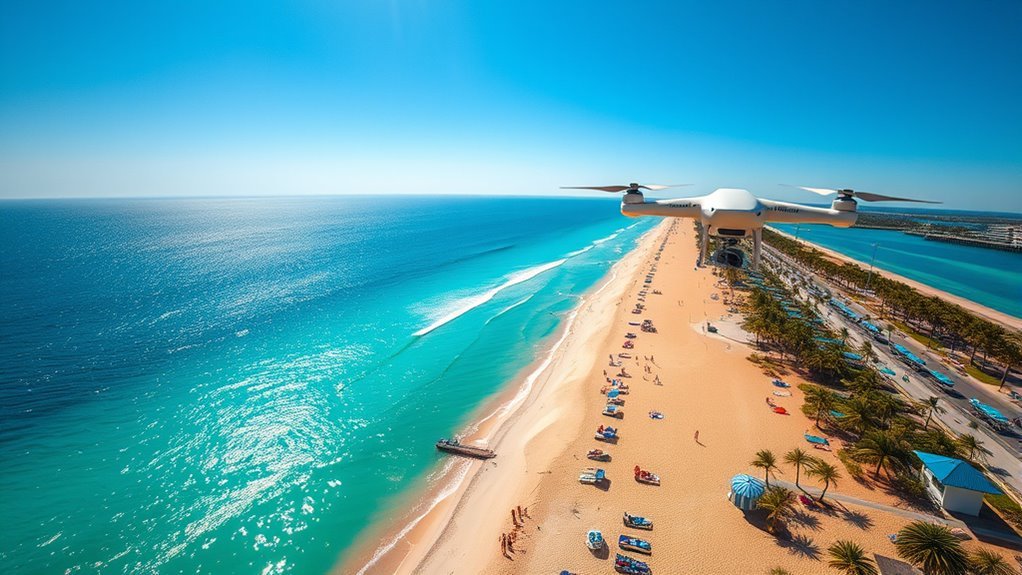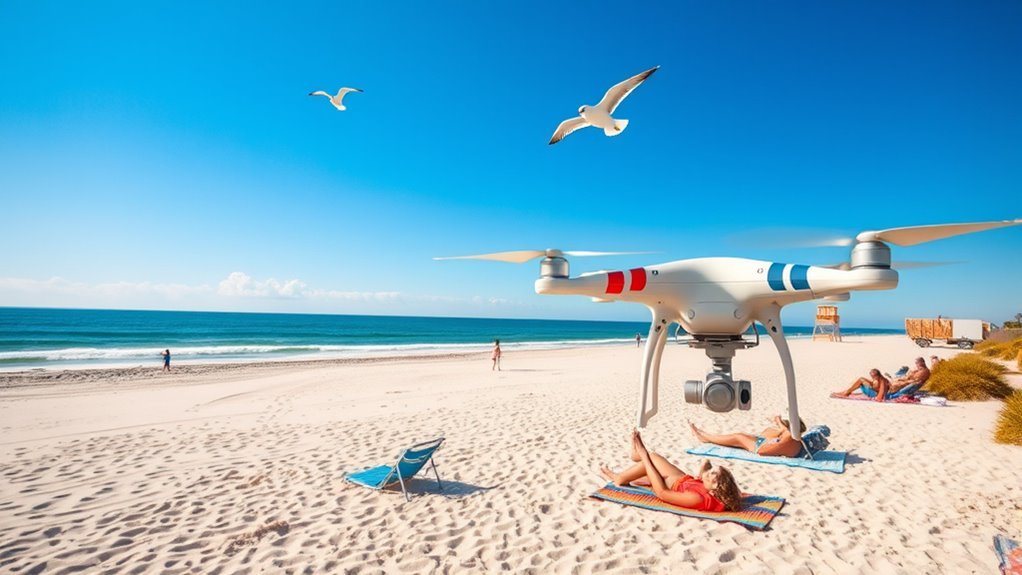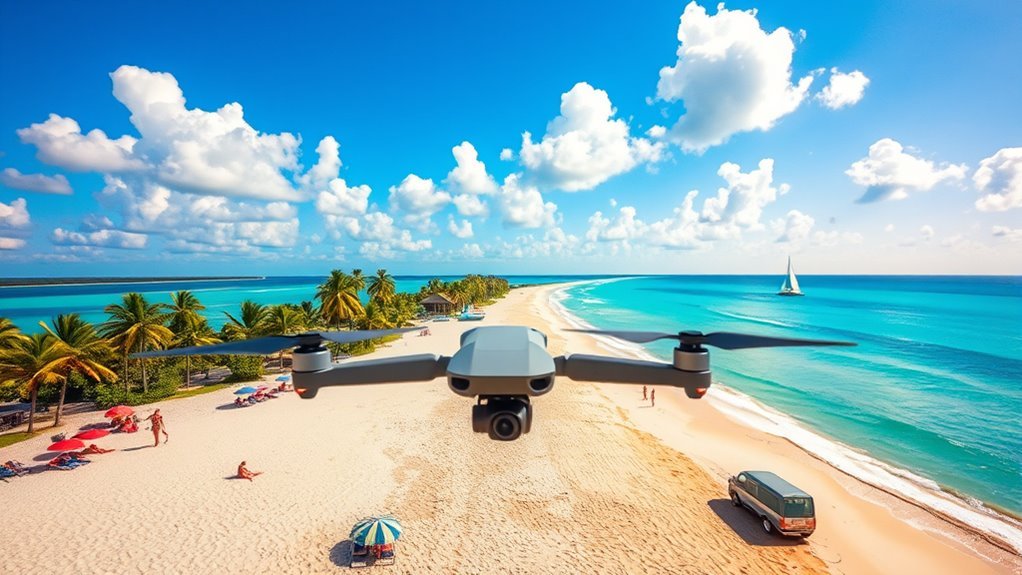To fly a drone at Florida beaches, you need to register it with the FAA if it weighs over 0.55 pounds and comply with state and local laws. Avoid no-fly zones near airports and protected areas, respect wildlife by keeping your distance, and check weather conditions to guarantee safe flights. Fly during less crowded times like mornings or late afternoons, keep your drone in sight, and prepare for emergencies. Master these basics, and you’ll be ready to capture stunning coastal shots while staying compliant and safe.
Understanding Florida’s Drone Laws and Regulations

Before you take off with your drone on Florida’s beaches, it is crucial to understand the state’s specific laws and regulations governing drone use. You must comply with both federal guidelines and Florida’s local ordinances, which can vary considerably from one beach to another. These rules often restrict flight times, altitudes, and proximity to people or wildlife. Securing drone insurance is highly recommended to protect yourself against liability or damage claims, especially in crowded or environmentally sensitive areas. Ignoring these regulations not only risks fines but can also jeopardize your freedom to fly. Always research the particular local ordinances of the beach you plan to visit beforehand, ensuring your drone activities remain lawful and respectful while you enjoy the skies with confidence.
Registering Your Drone Before Flying

Knowing the rules is just one part of preparing to fly your drone on Florida’s beaches. Before you launch, you must complete drone registration as mandated by FAA requirements. Any drone weighing more than 0.55 pounds and less than 55 pounds needs to be registered with the FAA, whether you’re flying recreationally or commercially. The process is straightforward: visit the FAA’s DroneZone website, provide your information, pay a small fee, and display your registration number on your drone. Skipping this step risks fines and grounding your flight. Registering guarantees you’re operating legally and protects your freedom to explore Florida’s stunning coastline from above. Stay compliant, and your drone adventures will remain hassle-free and enjoyable.
Identifying No-Fly Zones at Florida Beaches

Where can you not fly your drone on Florida’s beaches? Knowing these no-fly zones is essential to avoid legal trouble and guarantee safe, responsible flying. Strict no fly regulations apply near airports, military bases, state parks, and certain federal properties along the coast. To navigate these restrictions, you’ll want to consult updated drone maps, which clearly mark restricted and controlled airspace. These maps are your best tool to identify where drone flights are prohibited or require special authorization. Remember, ignoring no fly regulations can lead to hefty fines and confiscation of your drone. Stay informed by regularly checking official sources before each flight. This way, you maintain your freedom to explore the skies while respecting mandated boundaries on Florida’s beaches.
Respecting Wildlife and Protected Areas
When flying your drone at Florida beaches, you need to avoid nesting grounds to prevent disturbing vulnerable wildlife. Keep a safe distance from animals to respect their natural behavior and habitat. Following these guidelines helps protect protected areas and guarantees responsible drone use.
Avoid Nesting Grounds
Because Florida’s beaches serve as critical nesting sites for protected wildlife like sea turtles and shorebirds, you must avoid flying your drone near these areas. During nesting season, the presence of drones can disturb sensitive bird species and sea turtles, causing them to abandon nests or chicks. To protect these vulnerable animals and comply with local regulations, always check for posted signs and seasonal restrictions before flying. Avoid known nesting grounds entirely to prevent interference with breeding behaviors. Respecting these areas not only safeguards wildlife but also guarantees your freedom to fly responsibly without legal repercussions. By steering clear of nesting zones, you contribute to the preservation of Florida’s unique coastal ecosystems while enjoying your drone hobby without compromising environmental integrity.
Observe Wildlife Distances
Although drones offer remarkable views, you must maintain a safe distance from wildlife to prevent disturbance. Ethical flying means respecting animal habitats during your wildlife observation. Keep these guidelines in mind:
- Stay at least 100 feet away from birds and marine animals.
- Avoid flying directly over animals to prevent stress or altered behavior.
- Use zoom lenses to capture close-up shots without encroaching on space.
- Be aware of seasonal behaviors, like mating or feeding, which require extra caution.
- Comply with local regulations protecting wildlife and protected areas.
Best Times to Fly Your Drone at the Beach
Choosing the best times to fly your drone at Florida beaches can greatly enhance both your safety and the quality of your footage. Aim for early morning or late afternoon when the weather is calm and the prime lighting casts long, soft shadows. These periods offer the best weather conditions, reducing wind interference and improving drone stability. Midday often brings harsh sunlight and increased beach activity, which can compromise image quality and increase collision risks. Check local weather forecasts for clear skies and minimal wind speeds before flying. By planning your flights during these prime windows, you maximize control, capture stunning visuals, and respect beachgoers’ space. Prioritize these times to fully enjoy your drone freedom while ensuring responsible, safe operation.
Maintaining Visual Line of Sight During Flight
To guarantee safe and legal drone operation at Florida beaches, you must maintain a visual line of sight (VLOS) with your drone at all times. This means keeping your eyes on the drone without any visual aids, ensuring constant visual awareness of its positioning. Staying connected to your drone’s location helps you respond quickly to obstacles or changes in the environment.
To maintain effective VLOS, consider these tips:Consider flying within sight, avoiding obstacles, using landmarks, and minimizing distractions to keep your drone visible.
- Fly within a comfortable distance where your drone remains clearly visible
- Avoid flying behind obstacles like dunes or lifeguard towers
- Use natural landmarks to track drone positioning
- Minimize distractions and focus solely on the drone during flight
- Adjust your position to maintain continuous, unobstructed visual contact
Following these guidelines guarantees you retain control, comply with regulations, and enjoy the freedom to fly responsibly.
Avoiding Crowded Areas and Ensuring Safety
You should avoid flying your drone during peak crowd times to minimize risks and respect beachgoers’ privacy. Always maintain a safe distance from people, keeping your drone well clear of crowded areas. Prioritizing these precautions guarantees a safer experience for everyone.
Identify Peak Crowd Times
A clear understanding of peak crowd times at Florida beaches is vital for flying your drone safely and responsibly. Knowing when beaches are most crowded helps you avoid disturbances and guarantees your flights comply with safety norms. To identify these times, consider:
- Checking peak tourist seasons, typically winter and spring breaks.
- Reviewing local event calendars for festivals, sports events, or beach concerts.
- Monitoring weekends and public holidays when crowds swell.
- Noting early mornings and late afternoons as less crowded windows.
- Observing weather forecasts to predict lower attendance days.
Maintain Safe Flying Distance
Although it might be tempting to capture close-up shots, maintaining a safe flying distance from crowded areas is crucial for your drone’s operation and public safety. When flying at Florida beaches, you need to respect drone etiquette by avoiding congested spots where people gather. This not only minimizes the risk of accidents but also guarantees you’re compliant with local regulations. Keeping a clear buffer zone protects bystanders and preserves your equipment. For aerial photography, use your drone’s zoom capabilities instead of flying too close. This approach lets you enjoy creative freedom while prioritizing safety. Remember, responsible flying enhances everyone’s experience and keeps your drone hobby sustainable. Stay alert to your surroundings and adjust your flight path accordingly to maintain that necessary safe distance.
Weather Conditions to Consider for Beach Flying
Since coastal weather can change rapidly, it’s important to monitor conditions closely before flying your drone at Florida beaches. Understanding local weather patterns and wind speeds is vital to maintain control and guarantee safety. You should always check:
- Wind speeds, as gusts above 15 mph can destabilize your drone
- Incoming weather fronts that may bring sudden storms
- Humidity levels, which can affect drone electronics
- Visibility, to avoid obstacles and comply with regulations
- Tide schedules, since rising tides can limit safe takeoff and landing spots
Tips for Capturing Stunning Aerial Beach Photography
When aiming to capture stunning aerial beach photography, you’ll need to carefully plan your shots to highlight the unique textures, colors, and patterns of the shoreline. Mastering aerial composition means balancing elements like water, sand, and sky to create dynamic images. Also, take advantage of beach lighting—shoot during golden hours for soft shadows and vivid hues.
| Time of Day | Lighting Effect | Composition Tip |
|---|---|---|
| Sunrise | Warm, soft tones | Capture long shadows for depth |
| Midday | Bright, vivid colors | Use patterns in sand and waves |
| Sunset | Dramatic contrasts | Highlight silhouettes |
Handling Emergencies and Equipment Malfunctions
When flying your drone at Florida beaches, you need a clear plan for emergency landings and quick responses to battery failures. Knowing how to communicate effectively during malfunctions can prevent accidents and equipment loss. Preparing for these situations guarantees both your safety and the protection of your drone.
Emergency Landing Procedures
Although drone flights over Florida beaches are generally safe, you need to be prepared for emergencies and equipment malfunctions that require immediate landing. Conduct thorough pre flight checks and familiarize yourself with emergency protocols to handle unexpected situations efficiently.
When an emergency arises, follow these steps for a swift, controlled landing:
- Identify a clear, open area free of people and obstacles.
- Reduce altitude gradually while maintaining control.
- Activate the return-to-home function if available and safe.
- Communicate your intentions to bystanders when possible.
- Land smoothly to prevent damage to the drone and surroundings.
Battery Failure Response
Since battery failure can occur unexpectedly during your drone flight, you need to recognize early warning signs and act swiftly to maintain control and guarantee safety. Monitor your drone’s battery level closely; sudden drops or erratic readings indicate potential failure. Prioritize battery management by fully charging before flights and avoiding over-discharging. If you detect a battery malfunction, initiate an immediate, controlled landing in a safe area away from people and water to protect both your equipment and bystanders. Keep spare batteries on hand but replace any showing signs of wear or swelling. Mastering these battery failure responses is essential for drone safety, ensuring your freedom to fly responsibly while minimizing risks associated with equipment malfunctions on Florida’s beaches.
Communication During Malfunctions
Effective communication during drone malfunctions is essential to managing emergencies and minimizing risks on Florida’s beaches. When you spot malfunction indicators, you need to act swiftly and follow established communication protocols to guarantee safety and control. Here’s what you should do:
- Immediately notify nearby personnel and beach authorities using your radio or phone.
- Use clear, concise language to describe the malfunction and your drone’s location.
- Activate any onboard emergency signals to alert others visually or audibly.
- Follow your pre-planned communication protocols for reporting and coordinating recovery.
- Maintain constant updates until the drone is safely landed or recovered.

